Business Accounting and Finance: Assignment on Accounting Principles
VerifiedAdded on 2023/06/09
|6
|1358
|370
Homework Assignment
AI Summary
This assignment addresses key concepts in business accounting and finance. It begins by defining revenue and assets, and then explores whether credit sales fit these definitions. The solution explains the differences between cash and accrual basis accounting, outlining the advantages and disadvantages of each method. Finally, it discusses the balance sheet equation (Assets = Liabilities + Equity) and the double-entry system, emphasizing their importance for accurate financial reporting and error checking. The assignment provides a comprehensive understanding of fundamental accounting principles.
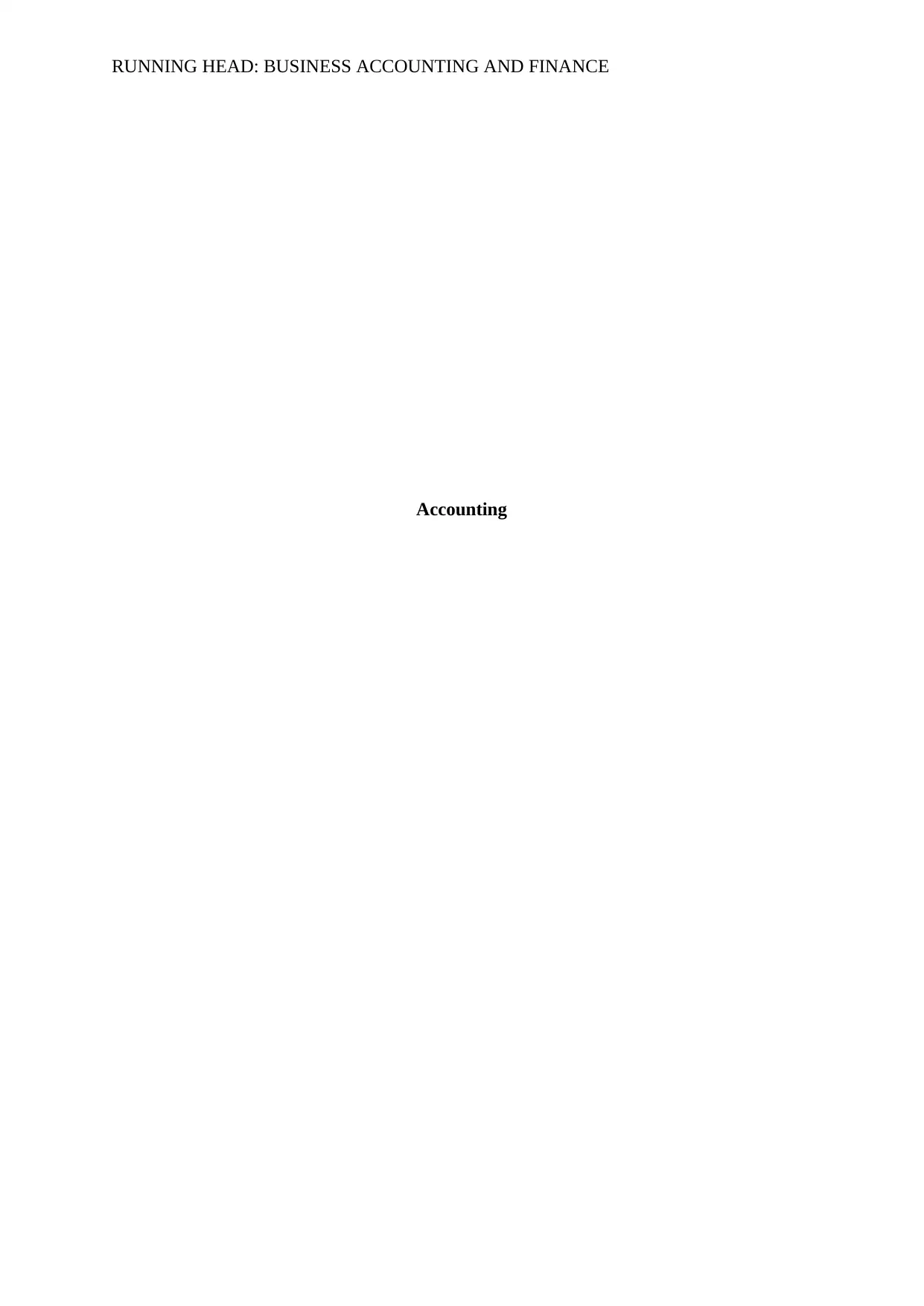
RUNNING HEAD: BUSINESS ACCOUNTING AND FINANCE
Accounting
Accounting
Paraphrase This Document
Need a fresh take? Get an instant paraphrase of this document with our AI Paraphraser
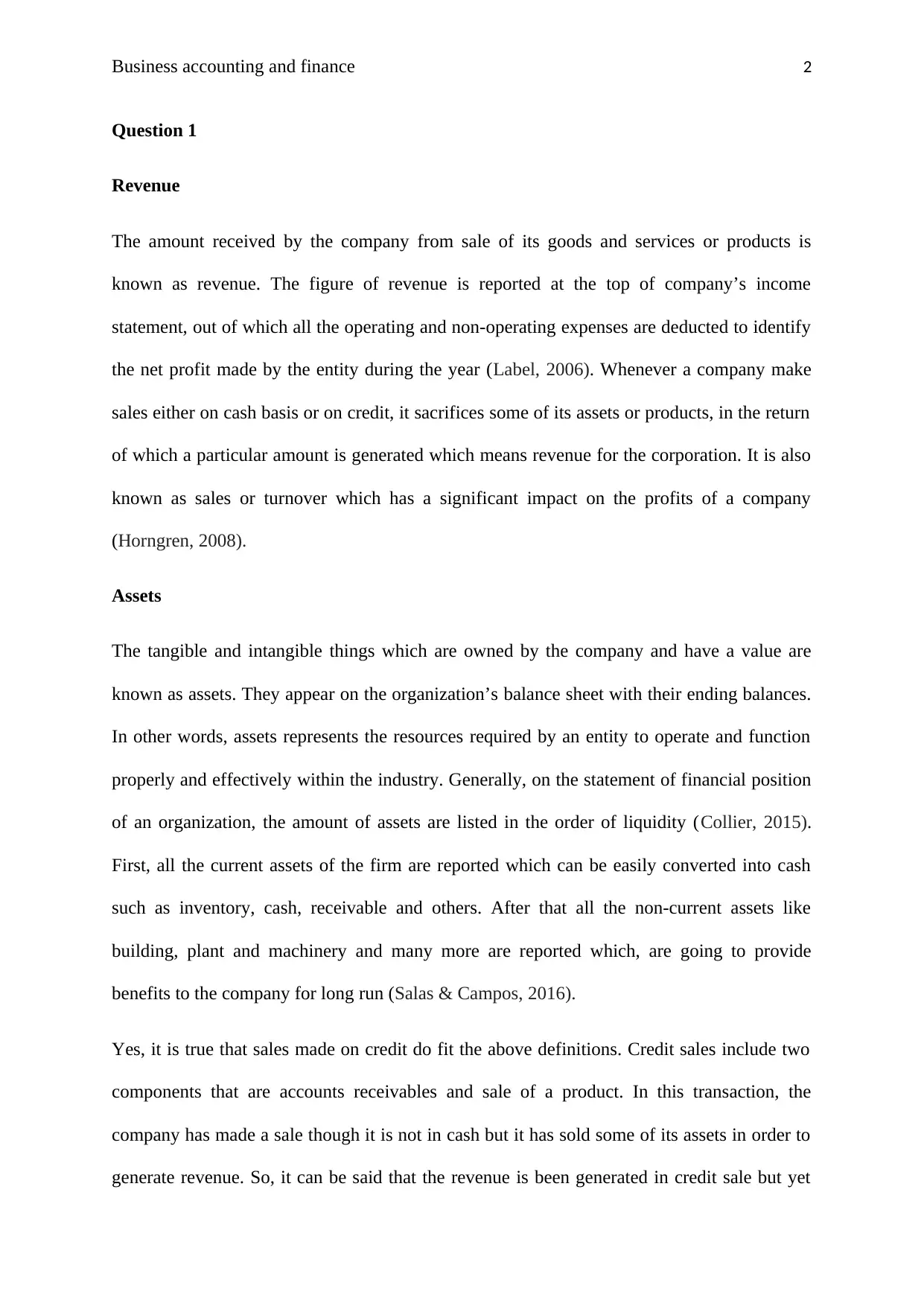
Business accounting and finance 2
Question 1
Revenue
The amount received by the company from sale of its goods and services or products is
known as revenue. The figure of revenue is reported at the top of company’s income
statement, out of which all the operating and non-operating expenses are deducted to identify
the net profit made by the entity during the year (Label, 2006). Whenever a company make
sales either on cash basis or on credit, it sacrifices some of its assets or products, in the return
of which a particular amount is generated which means revenue for the corporation. It is also
known as sales or turnover which has a significant impact on the profits of a company
(Horngren, 2008).
Assets
The tangible and intangible things which are owned by the company and have a value are
known as assets. They appear on the organization’s balance sheet with their ending balances.
In other words, assets represents the resources required by an entity to operate and function
properly and effectively within the industry. Generally, on the statement of financial position
of an organization, the amount of assets are listed in the order of liquidity (Collier, 2015).
First, all the current assets of the firm are reported which can be easily converted into cash
such as inventory, cash, receivable and others. After that all the non-current assets like
building, plant and machinery and many more are reported which, are going to provide
benefits to the company for long run (Salas & Campos, 2016).
Yes, it is true that sales made on credit do fit the above definitions. Credit sales include two
components that are accounts receivables and sale of a product. In this transaction, the
company has made a sale though it is not in cash but it has sold some of its assets in order to
generate revenue. So, it can be said that the revenue is been generated in credit sale but yet
Question 1
Revenue
The amount received by the company from sale of its goods and services or products is
known as revenue. The figure of revenue is reported at the top of company’s income
statement, out of which all the operating and non-operating expenses are deducted to identify
the net profit made by the entity during the year (Label, 2006). Whenever a company make
sales either on cash basis or on credit, it sacrifices some of its assets or products, in the return
of which a particular amount is generated which means revenue for the corporation. It is also
known as sales or turnover which has a significant impact on the profits of a company
(Horngren, 2008).
Assets
The tangible and intangible things which are owned by the company and have a value are
known as assets. They appear on the organization’s balance sheet with their ending balances.
In other words, assets represents the resources required by an entity to operate and function
properly and effectively within the industry. Generally, on the statement of financial position
of an organization, the amount of assets are listed in the order of liquidity (Collier, 2015).
First, all the current assets of the firm are reported which can be easily converted into cash
such as inventory, cash, receivable and others. After that all the non-current assets like
building, plant and machinery and many more are reported which, are going to provide
benefits to the company for long run (Salas & Campos, 2016).
Yes, it is true that sales made on credit do fit the above definitions. Credit sales include two
components that are accounts receivables and sale of a product. In this transaction, the
company has made a sale though it is not in cash but it has sold some of its assets in order to
generate revenue. So, it can be said that the revenue is been generated in credit sale but yet
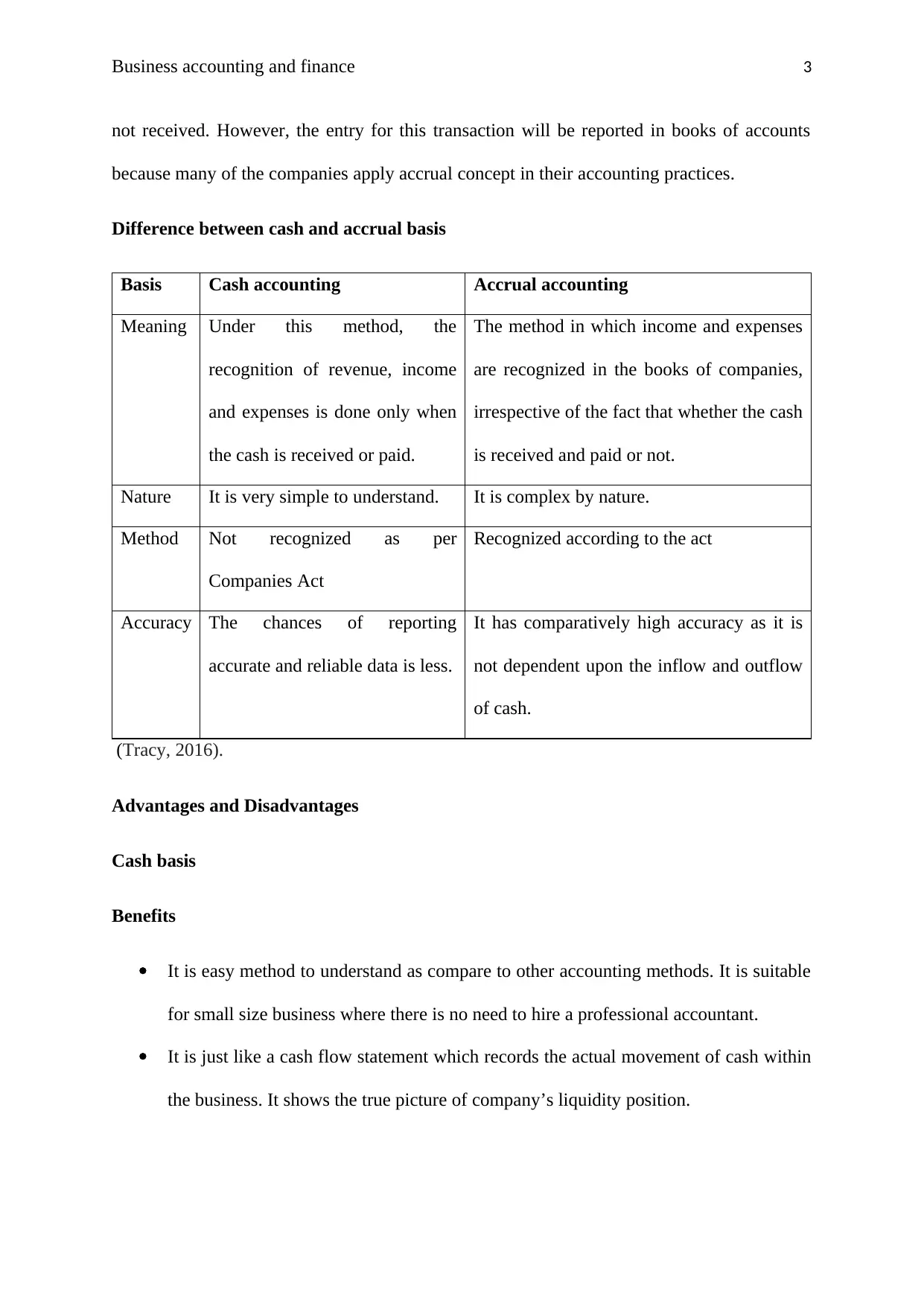
Business accounting and finance 3
not received. However, the entry for this transaction will be reported in books of accounts
because many of the companies apply accrual concept in their accounting practices.
Difference between cash and accrual basis
Basis Cash accounting Accrual accounting
Meaning Under this method, the
recognition of revenue, income
and expenses is done only when
the cash is received or paid.
The method in which income and expenses
are recognized in the books of companies,
irrespective of the fact that whether the cash
is received and paid or not.
Nature It is very simple to understand. It is complex by nature.
Method Not recognized as per
Companies Act
Recognized according to the act
Accuracy The chances of reporting
accurate and reliable data is less.
It has comparatively high accuracy as it is
not dependent upon the inflow and outflow
of cash.
(Tracy, 2016).
Advantages and Disadvantages
Cash basis
Benefits
It is easy method to understand as compare to other accounting methods. It is suitable
for small size business where there is no need to hire a professional accountant.
It is just like a cash flow statement which records the actual movement of cash within
the business. It shows the true picture of company’s liquidity position.
not received. However, the entry for this transaction will be reported in books of accounts
because many of the companies apply accrual concept in their accounting practices.
Difference between cash and accrual basis
Basis Cash accounting Accrual accounting
Meaning Under this method, the
recognition of revenue, income
and expenses is done only when
the cash is received or paid.
The method in which income and expenses
are recognized in the books of companies,
irrespective of the fact that whether the cash
is received and paid or not.
Nature It is very simple to understand. It is complex by nature.
Method Not recognized as per
Companies Act
Recognized according to the act
Accuracy The chances of reporting
accurate and reliable data is less.
It has comparatively high accuracy as it is
not dependent upon the inflow and outflow
of cash.
(Tracy, 2016).
Advantages and Disadvantages
Cash basis
Benefits
It is easy method to understand as compare to other accounting methods. It is suitable
for small size business where there is no need to hire a professional accountant.
It is just like a cash flow statement which records the actual movement of cash within
the business. It shows the true picture of company’s liquidity position.
⊘ This is a preview!⊘
Do you want full access?
Subscribe today to unlock all pages.

Trusted by 1+ million students worldwide
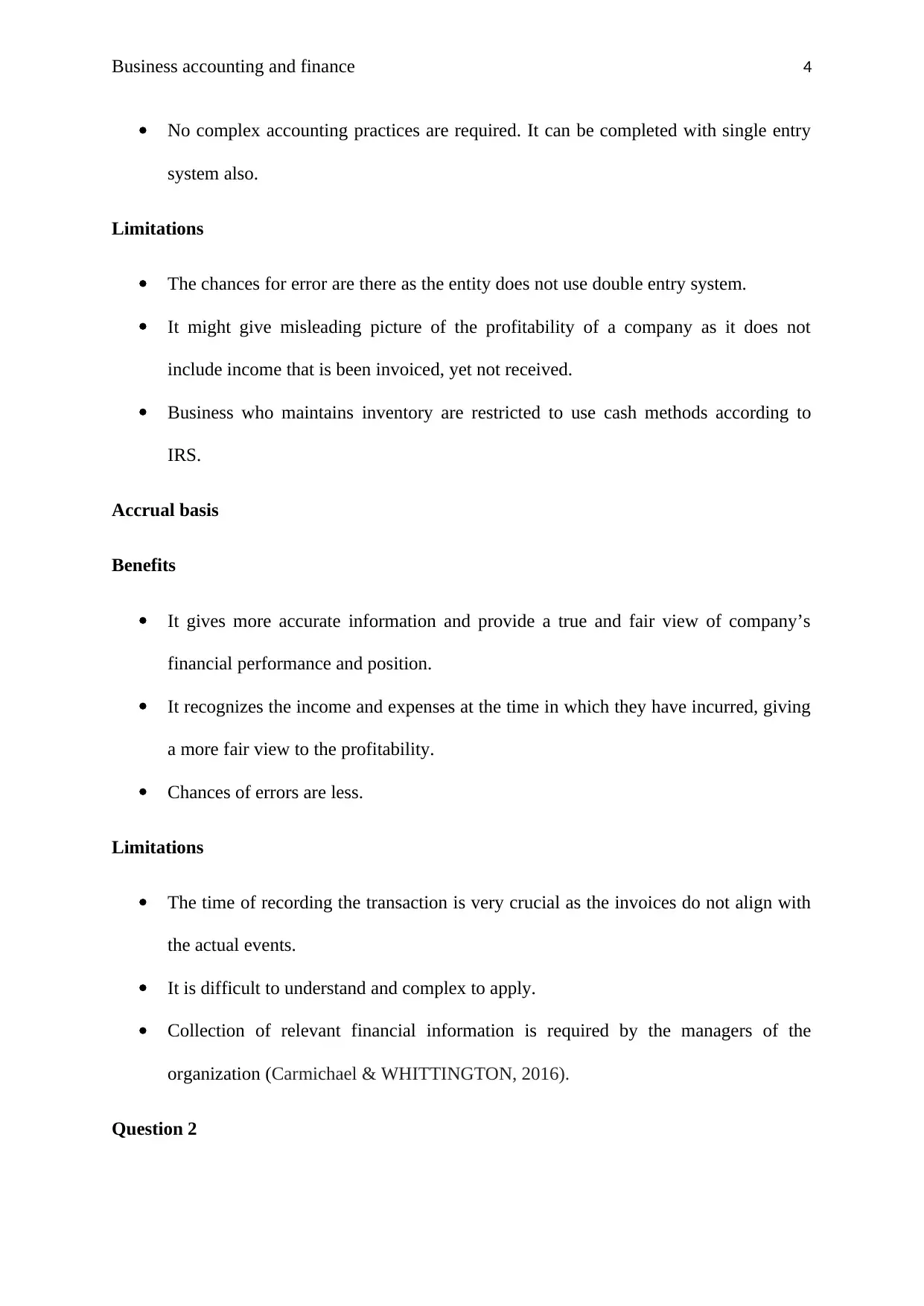
Business accounting and finance 4
No complex accounting practices are required. It can be completed with single entry
system also.
Limitations
The chances for error are there as the entity does not use double entry system.
It might give misleading picture of the profitability of a company as it does not
include income that is been invoiced, yet not received.
Business who maintains inventory are restricted to use cash methods according to
IRS.
Accrual basis
Benefits
It gives more accurate information and provide a true and fair view of company’s
financial performance and position.
It recognizes the income and expenses at the time in which they have incurred, giving
a more fair view to the profitability.
Chances of errors are less.
Limitations
The time of recording the transaction is very crucial as the invoices do not align with
the actual events.
It is difficult to understand and complex to apply.
Collection of relevant financial information is required by the managers of the
organization (Carmichael & WHITTINGTON, 2016).
Question 2
No complex accounting practices are required. It can be completed with single entry
system also.
Limitations
The chances for error are there as the entity does not use double entry system.
It might give misleading picture of the profitability of a company as it does not
include income that is been invoiced, yet not received.
Business who maintains inventory are restricted to use cash methods according to
IRS.
Accrual basis
Benefits
It gives more accurate information and provide a true and fair view of company’s
financial performance and position.
It recognizes the income and expenses at the time in which they have incurred, giving
a more fair view to the profitability.
Chances of errors are less.
Limitations
The time of recording the transaction is very crucial as the invoices do not align with
the actual events.
It is difficult to understand and complex to apply.
Collection of relevant financial information is required by the managers of the
organization (Carmichael & WHITTINGTON, 2016).
Question 2
Paraphrase This Document
Need a fresh take? Get an instant paraphrase of this document with our AI Paraphraser
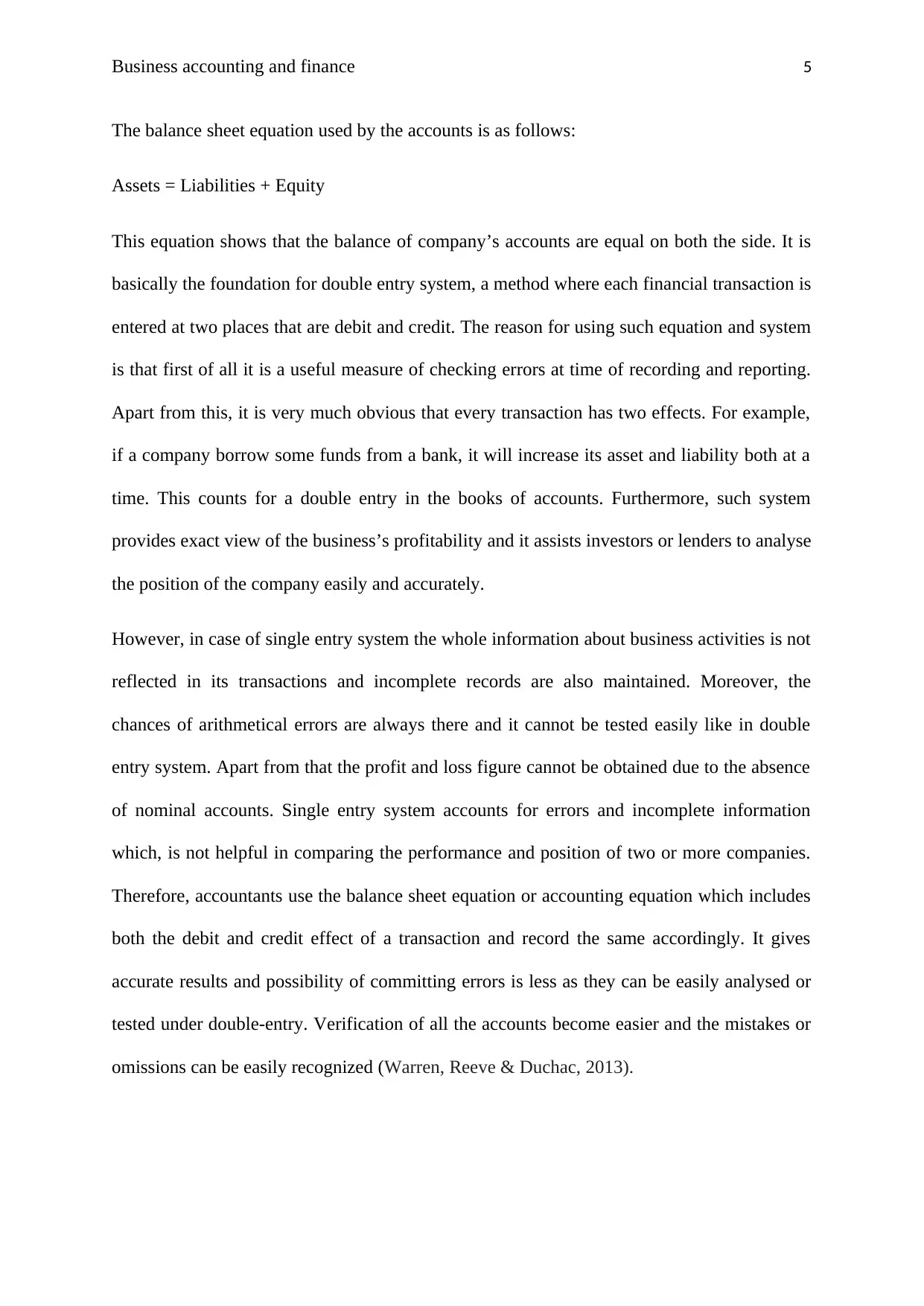
Business accounting and finance 5
The balance sheet equation used by the accounts is as follows:
Assets = Liabilities + Equity
This equation shows that the balance of company’s accounts are equal on both the side. It is
basically the foundation for double entry system, a method where each financial transaction is
entered at two places that are debit and credit. The reason for using such equation and system
is that first of all it is a useful measure of checking errors at time of recording and reporting.
Apart from this, it is very much obvious that every transaction has two effects. For example,
if a company borrow some funds from a bank, it will increase its asset and liability both at a
time. This counts for a double entry in the books of accounts. Furthermore, such system
provides exact view of the business’s profitability and it assists investors or lenders to analyse
the position of the company easily and accurately.
However, in case of single entry system the whole information about business activities is not
reflected in its transactions and incomplete records are also maintained. Moreover, the
chances of arithmetical errors are always there and it cannot be tested easily like in double
entry system. Apart from that the profit and loss figure cannot be obtained due to the absence
of nominal accounts. Single entry system accounts for errors and incomplete information
which, is not helpful in comparing the performance and position of two or more companies.
Therefore, accountants use the balance sheet equation or accounting equation which includes
both the debit and credit effect of a transaction and record the same accordingly. It gives
accurate results and possibility of committing errors is less as they can be easily analysed or
tested under double-entry. Verification of all the accounts become easier and the mistakes or
omissions can be easily recognized (Warren, Reeve & Duchac, 2013).
The balance sheet equation used by the accounts is as follows:
Assets = Liabilities + Equity
This equation shows that the balance of company’s accounts are equal on both the side. It is
basically the foundation for double entry system, a method where each financial transaction is
entered at two places that are debit and credit. The reason for using such equation and system
is that first of all it is a useful measure of checking errors at time of recording and reporting.
Apart from this, it is very much obvious that every transaction has two effects. For example,
if a company borrow some funds from a bank, it will increase its asset and liability both at a
time. This counts for a double entry in the books of accounts. Furthermore, such system
provides exact view of the business’s profitability and it assists investors or lenders to analyse
the position of the company easily and accurately.
However, in case of single entry system the whole information about business activities is not
reflected in its transactions and incomplete records are also maintained. Moreover, the
chances of arithmetical errors are always there and it cannot be tested easily like in double
entry system. Apart from that the profit and loss figure cannot be obtained due to the absence
of nominal accounts. Single entry system accounts for errors and incomplete information
which, is not helpful in comparing the performance and position of two or more companies.
Therefore, accountants use the balance sheet equation or accounting equation which includes
both the debit and credit effect of a transaction and record the same accordingly. It gives
accurate results and possibility of committing errors is less as they can be easily analysed or
tested under double-entry. Verification of all the accounts become easier and the mistakes or
omissions can be easily recognized (Warren, Reeve & Duchac, 2013).
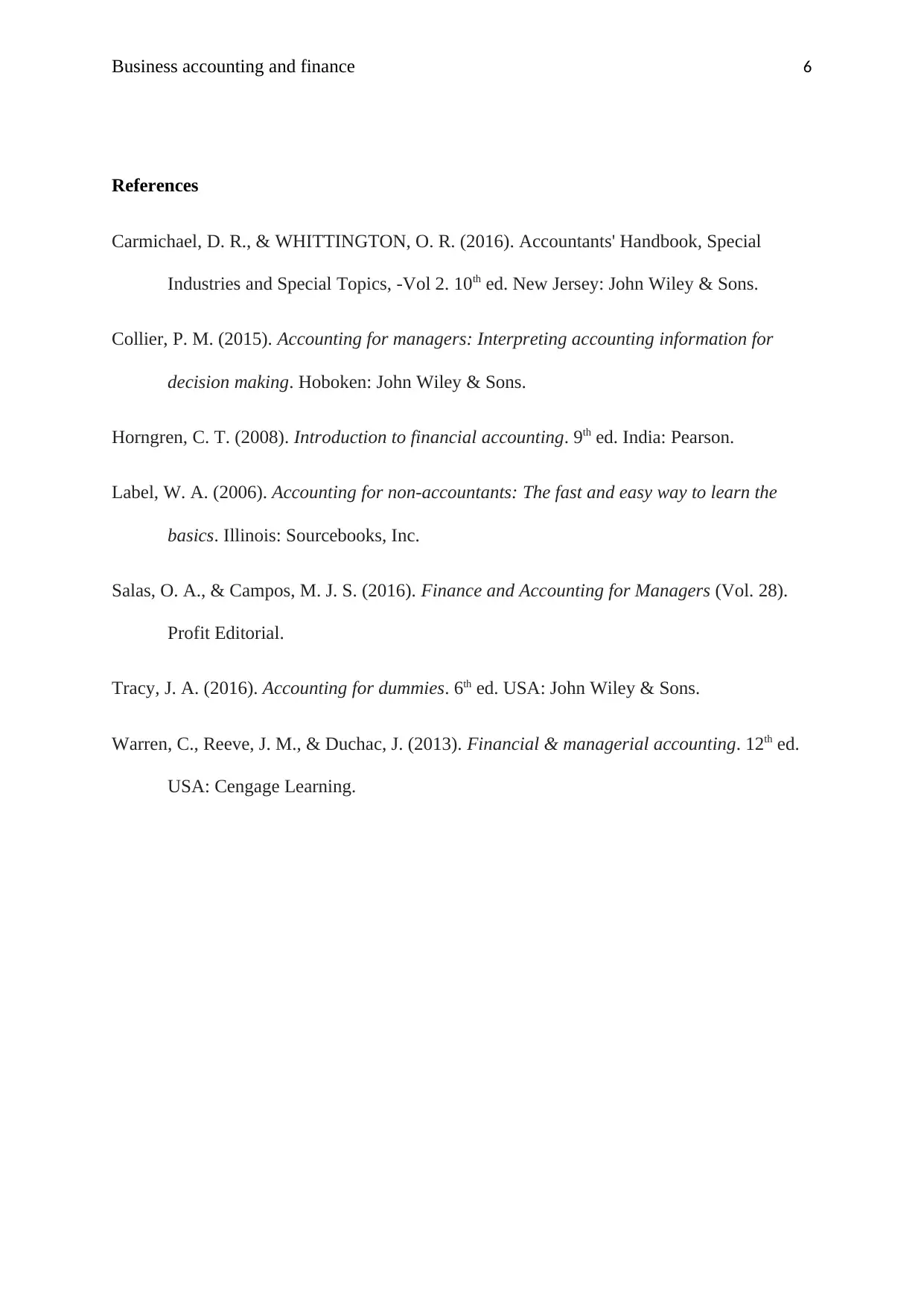
Business accounting and finance 6
References
Carmichael, D. R., & WHITTINGTON, O. R. (2016). Accountants' Handbook, Special
Industries and Special Topics, -Vol 2. 10th ed. New Jersey: John Wiley & Sons.
Collier, P. M. (2015). Accounting for managers: Interpreting accounting information for
decision making. Hoboken: John Wiley & Sons.
Horngren, C. T. (2008). Introduction to financial accounting. 9th ed. India: Pearson.
Label, W. A. (2006). Accounting for non-accountants: The fast and easy way to learn the
basics. Illinois: Sourcebooks, Inc.
Salas, O. A., & Campos, M. J. S. (2016). Finance and Accounting for Managers (Vol. 28).
Profit Editorial.
Tracy, J. A. (2016). Accounting for dummies. 6th ed. USA: John Wiley & Sons.
Warren, C., Reeve, J. M., & Duchac, J. (2013). Financial & managerial accounting. 12th ed.
USA: Cengage Learning.
References
Carmichael, D. R., & WHITTINGTON, O. R. (2016). Accountants' Handbook, Special
Industries and Special Topics, -Vol 2. 10th ed. New Jersey: John Wiley & Sons.
Collier, P. M. (2015). Accounting for managers: Interpreting accounting information for
decision making. Hoboken: John Wiley & Sons.
Horngren, C. T. (2008). Introduction to financial accounting. 9th ed. India: Pearson.
Label, W. A. (2006). Accounting for non-accountants: The fast and easy way to learn the
basics. Illinois: Sourcebooks, Inc.
Salas, O. A., & Campos, M. J. S. (2016). Finance and Accounting for Managers (Vol. 28).
Profit Editorial.
Tracy, J. A. (2016). Accounting for dummies. 6th ed. USA: John Wiley & Sons.
Warren, C., Reeve, J. M., & Duchac, J. (2013). Financial & managerial accounting. 12th ed.
USA: Cengage Learning.
⊘ This is a preview!⊘
Do you want full access?
Subscribe today to unlock all pages.

Trusted by 1+ million students worldwide
1 out of 6
Related Documents
Your All-in-One AI-Powered Toolkit for Academic Success.
+13062052269
info@desklib.com
Available 24*7 on WhatsApp / Email
![[object Object]](/_next/static/media/star-bottom.7253800d.svg)
Unlock your academic potential
Copyright © 2020–2025 A2Z Services. All Rights Reserved. Developed and managed by ZUCOL.





